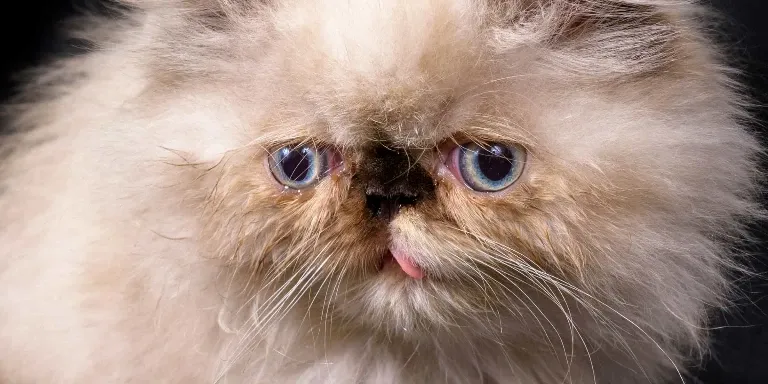The Best Fluffy Pancakes recipe you will fall in love with. Full of tips and tricks to help you make the best pancakes.

If you are one of the millions of people who suffer from cat allergies, you know how frustrating it can be to be around these furry creatures. Sneezing, itching, and watery eyes can make it difficult to enjoy the company of your feline friends.
Himalayan cats are not hypoallergenic. They have long fur and shed regularly, which can contribute to allergies in some people. However, some people with allergies may be able to tolerate Himalayan cats better than other breeds due to their low dander levels.
Before we dive into the specifics of Himalayan cats and allergens, it’s important to understand what causes cat allergies in the first place. Contrary to popular belief, it’s not cat hair that triggers allergies, but rather proteins found in their saliva, urine, and dander (dead skin cells).
When cats groom themselves, they spread these proteins throughout their fur, which can then be transferred to humans when petting or cuddling. This can lead to a range of allergic reactions, from mild to severe.
With this in mind, let’s explore whether Himalayan cats may be a viable option for those with cat allergies.
Understanding Cat Allergies
Don’t let cat allergies hold you back from snuggling up with your furry friend – understanding how they work can make all the difference!
Cat allergies are caused by proteins found in a cat’s saliva, urine, and skin cells, which can trigger an allergic reaction when they come into contact with a person’s skin or respiratory system. Common cat allergy symptoms include sneezing, runny nose, itchy eyes, and even asthma attacks in severe cases.
If you or someone in your household is allergic to cats but still wants to enjoy their company, there are preventative measures you can take. Regular grooming and bathing of your cat can reduce the amount of allergens they produce, as well as vacuuming and dusting frequently to remove any airborne allergens. Additionally, there are air purifiers and filters specifically designed to capture pet allergens, which can be helpful in reducing symptoms.
By taking these precautions, you can still enjoy the love and companionship of a cat without suffering from allergies.
What Does “Hypoallergenic”Mean?
Understanding what it means to be hypoallergenic can be tricky, as it’s not a guarantee that a particular animal won’t cause allergies. The term ‘hypoallergenic’ refers to animals that produce fewer allergens, making them a better option for people with allergies.
However, it’s important to note that no cat breed is completely hypoallergenic, and some people may still experience allergic reactions even with breeds that are labeled as such. Despite this, there are still certain benefits to owning a cat that is labeled as hypoallergenic.
These cats produce fewer allergens, which means that they may cause fewer allergic reactions or less severe reactions in people with allergies. Additionally, there are alternative options for people with allergies who still want to own a cat, such as regularly grooming and bathing their cat, using air purifiers, and taking allergy medications.
Ultimately, the decision to own a cat should be based on individual circumstances and allergies, and consulting with a doctor or allergist can help determine the best course of action.
The Himalayan Cat Breed
If you’re interested in the Himalayan cat breed, you should know about its history and characteristics.
This breed is a cross between the Siamese and Persian breeds, making it a unique and interesting feline.
However, like all cat breeds, Himalayans are prone to common health issues such as respiratory problems and dental disease.
History and Characteristics
You’ll love the Himalayan cat’s distinct features, such as their long hair and flat faces, which are a result of their Persian and Siamese ancestry. These cats were first bred in the 1930s, with the aim of creating a cat that had the Siamese’s coloring but with the Persian’s long hair.
The result was a cat that had a unique look and a personality that was a mix of both breeds. Himalayan cats require regular grooming due to their long hair, which can easily become matted if not brushed frequently. Their grooming needs are similar to those of Persian cats, and it’s recommended that they be brushed daily.
Their eyes also require regular cleaning to prevent discharge from accumulating around the eye area. Despite their grooming needs, Himalayan cats make excellent pets and are known for their affectionate and docile personalities.
Common Health Issues
To keep your Himalayan cat healthy, it’s important to be aware of common health issues that may affect this breed. One of the most common health issues in Himalayan cats is urinary tract problems. This breed is prone to developing bladder stones and urinary tract infections, which can be painful and even life-threatening if left untreated.
To prevent these issues, make sure your cat has access to plenty of fresh water and a healthy diet that’s low in magnesium and phosphorus. Another important health concern for Himalayan cats is dental disease. This breed is predisposed to developing periodontal disease and tooth decay due to their short, flat faces and crowded teeth.
To prevent dental issues, make sure to brush your cat’s teeth regularly and provide them with dental chews or toys. Additionally, feeding your cat a diet that’s high in protein and low in carbohydrates can help prevent dental issues and other health problems. By being proactive with preventive measures and dietary requirements, you can help ensure your Himalayan cat lives a long and healthy life.
Allergen Production in Himalayan Cats
When living with a Himalayan cat, you may still experience allergies despite their long hair and reputation as hypoallergenic due to their production of the allergen Fel d 1. This allergen is found in the cat’s saliva, urine, and skin glands, and can cause symptoms such as sneezing, itching, and hives.
Your friend may have adopted a Himalayan cat and noticed an increase in their allergy symptoms, even with regular grooming and cleaning of the cat’s hair. To reduce allergen production in Himalayan cats, it’s important to focus on reducing the amount of dander in the environment.
Dander is the dead skin cells that are shed by the cat and can contain the Fel d 1 allergen. Some ways to reduce dander production include frequent grooming techniques such as brushing and bathing, as well as using air cleaners and HEPA filters in the home. However, it’s important to note that even with these measures, Himalayan cats may still produce allergens and trigger allergy symptoms in some individuals.
Studies on Hypoallergenic Properties of Himalayan Cats
New studies have explored whether Himalayan felines truly have a hypoallergenic effect on humans. Genetic research has revealed that the protein responsible for causing allergies in cats is called Fel d 1.
This protein is found in the saliva, urine, and skin of cats, and can be spread through shedding of fur. However, research has shown that Himalayan cats produce less of this allergen compared to other cat breeds. This is due to a genetic mutation that affects the enzyme responsible for producing Fel d 1.
Environmental factors can also play a role in the hypoallergenic properties of Himalayan cats. For example, the amount of allergen produced may vary depending on the cat’s diet, grooming habits, and living conditions. Additionally, frequent bathing and brushing can help reduce the amount of allergen present on the cat’s fur.
While Himalayan cats may not be completely hypoallergenic, they may be a good choice for individuals with allergies who still want to enjoy the company of a feline companion.
Other Strategies for Managing Cat Allergies
If you’re suffering from cat allergies, there are several strategies you can use to manage your symptoms. One effective method is to invest in an air purifier or filter, which can help remove allergens from the air.
You can also try allergy shots or medications, which can help reduce your body’s reaction to cat allergens.
Air Purifiers and Filters
You’ll want to invest in an air purifier or filter if you’re considering adopting a Himalayan cat but suffer from allergies. An air purifier can help reduce the amount of cat allergens in the air, making it easier for you to breathe.
There are several benefits to using an air purifier or filter, including:
- Improved air quality: Air purifiers and filters can remove pollutants and allergens from the air, making it cleaner and easier to breathe.
- Reduced allergy symptoms: By removing allergens from the air, air purifiers and filters can help reduce allergy symptoms such as sneezing, coughing, and itchy eyes.
- Better overall health: Improved air quality can have a positive impact on your overall health, helping to reduce the risk of respiratory problems and other health issues.
To keep your air purifier or filter working effectively, it’s important to perform regular maintenance. This may include changing the filter, cleaning the unit, and monitoring the air quality in your home.
By investing in an air purifier or filter and taking proper care of it, you can enjoy the benefits of cleaner, healthier air in your home.
Allergy Shots and Medications
Don’t let allergies stop you from enjoying time with your furry friends. Allergy shots and medications are viable options that can help alleviate symptoms and make it easier to live with pets. Consult with your doctor to determine which treatment plan is best for you.
If you prefer alternatives to medication, there are lifestyle changes that you can make to reduce your allergy symptoms. Regular cleaning of your home and your pet’s living space can decrease the amount of allergens in the air. Additionally, consider using air purifiers and filters to improve the air quality in your home.
With the right treatment plan and lifestyle changes, you can enjoy the company of your Himalayan cat without the discomfort of allergies.
Tips for Living with a Himalayan Cat
Living with a Himalayan cat can be a wonderful experience, and there are a few tips that can make it even better.
One of the first things to consider is litter box training. It’s important to keep the litter box clean and in a private location to ensure your cat is comfortable and doesn’t develop any bad habits. Also, introducing your cat to the litter box at a young age is key to making sure they understand where to go when they need to use the restroom.
Another important aspect of living with a Himalayan cat is grooming. These cats have a long, thick coat that requires regular brushing to prevent matting and hairballs. It’s recommended to brush your cat at least once a week, but more frequently during shedding season. Additionally, regular nail trimming and teeth cleaning should be incorporated into your grooming routine.
By following these tips, you can ensure a happy and healthy life with your furry friend.
Can Mixed Breed Cats Have the Same Hypoallergenic Qualities as Himalayan Cats?
Yes, mixed breed cats can be a hypoallergenic option for those allergic to cats. While Himalayan cats are known for their low allergen qualities, mixed breed cats can also possess the same hypoallergenic qualities, making them a suitable choice for allergy sufferers looking for a feline companion.
Conclusion
So, you’re considering getting a Himalayan cat, but you’re worried about your allergies. After all, cat allergies can make it difficult to enjoy spending time with your feline friend.
While Himalayan cats are not completely hypoallergenic, there is evidence to suggest that they may produce less allergens than other cat breeds. Studies have shown that Himalayan cats produce less of a protein called Fel d 1, which is a common allergen in cats.
Additionally, there are strategies for managing cat allergies, such as regularly bathing your cat and keeping your home clean. While there is no guarantee that you won’t experience allergies with a Himalayan cat, these strategies may help to minimize your symptoms.
In the end, it’s up to you to decide if the potential benefits of having a Himalayan cat outweigh the risks of allergies. With proper management and care, you may be able to enjoy the companionship of a Himalayan cat without experiencing severe allergies. Don’t let allergies hold you back from the joy of having a furry friend by your side.








